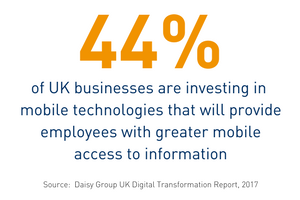
Daisy’s digital expert shares his advice on how to make mobile working work.
Agile working, mobile working and remote working – whatever you want to call it – the practice of allowing staff to work outside of the office is extremely popular among the majority of UK businesses.
But what does it involve, how is it implemented and is it right for every business?
Daisy’s Chief Digital Officer Nathan Marke sheds light on some of the most frequently asked questions about remote working, discusses the pros and cons of its adoption, and offers his thoughts on how you can create a workforce that can work from anywhere and on any device.
Why do you think the shift from office-based jobs to remote workers has become a popular choice for many businesses?
NM: People today expect to be connected anytime, anywhere and on any device – and this is a huge productivity gain for businesses. The explosion of mobile technologies offers a number of opportunities for both employers and employees to benefit. For businesses, allowing staff to work from home can lower absenteeism, increase productivity, improve morale and save money. For employees, flexibility is often a key element when considering a job offer, so by offering the option, you have access to an increased talent pool that isn’t limited by geographical restrictions.
There’s also the disruption element. If you have a workforce that is 100% office-based, and something happens to that office that is out of your control – such as a fire or a flood – then you’re going to feel the effects pretty quickly. Your customers are going to suffer from the disruption which is going to affect your reputation and, ultimately, this will hit your bottom line.
What should be the first step that a small business should take when wanting to allow employees to work from home?
NM: It’s important to remember that remote working won’t work for everyone and one size doesn’t fit all. For example, retailers will still require in-store assistants in their shops. Every business and every job role is different so the obvious place to start is to assess who you’ve got and what you’ve got.
The first consideration should always be the human element. When considering particular teams or individual employees, you should look at performance history to establish if they are self-driven or whether they require guidance. You also need to remain fair; if you permit some the option and not others, this could cause motivation and performance issues. See if you can create common personas for the types of roles in your business so that you can design a needs profile for each persona.
Next, you need to examine what you’ll need from a logistics point of view to make it work. If you already have the technology and processes in place, then yes, consider if you can afford to be more flexible. If it’s going to mean a significant change in operations, then you might need to introduce new technology slowly and train your staff on how to use it before allowing them to work remotely.
How can businesses ensure that employees working remotely resist the temptations of Netflix and stay productive?
NM: Businesses need to have a trusting culture to fully support remote working, which may not necessarily work well in companies where team members aren’t already given the autonomy and freedom to manage their own tasks and work patterns.
Targets and objectives will remain the same no matter where someone chooses to work, but there needs to be more of a conscious effort to communicate. In types of work where outputs can be quantified – such as data entry work, deliveries and service work – it’s possible to use technology to set and measure performance targets.
How can businesses determine which tools are best?

NM: That all depends on the nature of your business and how your team communicates and collaborates. There are hundreds of fantastic applications available that can assist with many, many different aspects of a business. Skype for Business, as an example, is great for communicating in real time, offering an instant messaging platform as well as allowing for video conferencing and web-based calls.
I think the best starting point for any business is the creation of a virtual private network (VPN) – essential in keeping mobile and remote workers secure. This enables the sending of data over the internet without it being intercepted.
Is remote working something that any business can adopt?
NM: To an extent. We’ve seen a huge shift in consumer behaviour over the past ten years, we do the majority of our food shop online, we bank online, we meet partners online, so it’s possible to translate that into business. But for industries such as retail, total remote working is not necessarily possible.
There is still a real need for these types of businesses to have both an online and high street presence in order to stay competitive, so you’re always going to need people on the front line – at least for now.
But technology is a great enabler and there are opportunities to carry out some processes remotely. There’s no reason why your most of your meetings, for example, can’t be done in this way to save both time and money. It’s up to a business to identify where there are opportunities to cut costs and be savvier.
Is there a danger of losing the contrast between where you live and where you work? Is having that difference important?
NM: There are arguments for and against. When you ask people why they like having the option to work from home, you can probably imagine that the most common responses are that it relieves stress levels and supports a healthier work-life balance. For those that work in an office, cutting out a commute can make the world of difference to stress levels and overall health as well as substantial financial savings.
In contrast, as an employer you have a duty of care to your employees and, as such, having systems in place that make communications easy, you can lose visibility of something that might be seriously affecting members of your team. A crisis at home will very likely impact an employee’s output when that environment becomes toxic, so you might argue that intervening at a crucial point isn’t possible.
Why do you think so many employers are still pessimistic about adopting a working from home ethos?
NM: I think many businesses are still caught up in a culture change versus technology clash; culturally they are still working in the ‘old world’ which was based around attendance, visibility, work-critical factors and as a result, the technology used has perhaps never caught up.
But if you look at those factors, they are all input measures rather than output measures. I think businesses have got to rethink KPIs and what’s actually important and then assess whether an individual role can be performed using output measures where therefore attendance, visibility etc. are no longer relevant. So it’s essentially a switch of mindset for leaders to measure results by output rather than input; that is what enables an agile workforce.
How can businesses overcome the security concerns of remote working?
NM: One of the biggest challenges is keeping the software on remote devices up to date. Out-of-date software is one of the many primary targets of attacks by hackers who essentially know that older versions contain vulnerabilities to exploit. You need to have processes put in place that enable you to update remote devices and laptops on a regular basis.
As well as that, you need to make sure that the data that these devices hold is backed up off the machine and encrypted. This means the hard drives of your laptops as well as any mobile phones and tablets. That way, should a device be lost or stolen or left on the Tube, you can be confident that the information stored on it will be kept secure and can be restored from the latest backup without losing days of data. You may also want to look into remotely wiping any devices using mobile device management technology to add that extra peace of mind.
Do you foresee the demand for fixed office spaces dying out completely, and if so how soon?
NM: No, absolutely not. Despite advantages in technology, human beings need to interact. I believe people need to get together – it’s part of the human condition.
But obviously, the workplace will change. It will increasingly become a hybrid of face-to-face collaboration coupled with an increasing blend of digital tools. You don’t need fixed office space in order to collaborate so in theory, yes, many companies could do away with the office altogether or at the very least reduce bricks and mortar considerably. But again, in doing that, you lose those face-to-face conversations that occur away from the pressure cooker. In my experience, some of the best ideas I have are spawned from accidentally bumping into two or three colleagues at the coffee machine.